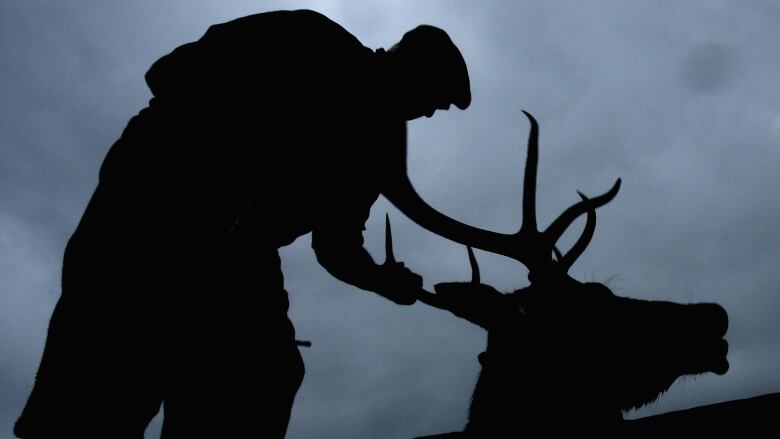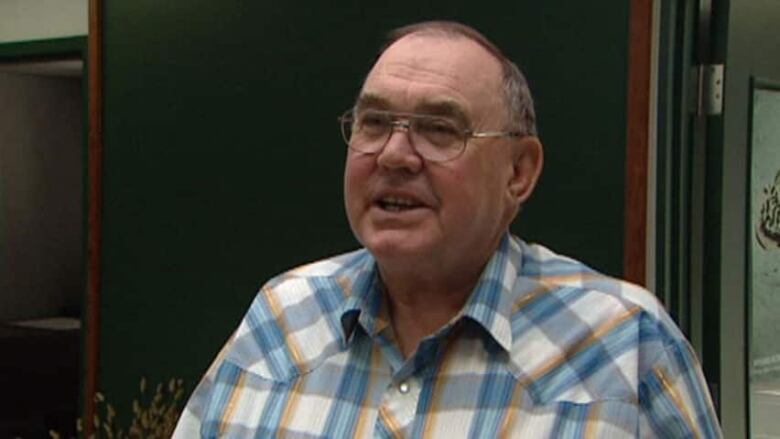Respecting treaty rights: Night hunting lessons from former Saskatchewan legislator
Saskatchewan banned spotlighting in 1998 with the support of Indigenous communities

The moose population was down, Mtis hunting rights were caught up in a court battle and Saskatchewan partnered with Indigenous leaders to limit "spotlighting," a controversial hunting technique.
On Feb. 10, 1998 then Saskatchewan Environment and Resource Management Minister Lorne Scott announced amendments to the Wildlife Regulations, banning the use of spotlights, jacklights, night-vision rifle scopes or any artificial light, including vehicle headlights, for the purpose of hunting any wildlife.
The process Saskatchewan took 19 years ago is what many Manitobans are looking at as the night hunting debate continues in the province.
- ANALYSIS: What's missing from Manitoba's night hunting debate is evidence
- Minister won't say whether night hunting ban is on the table
This week, rural politicians from across southwestern Manitoba convened in Winnipeg with a united goal in mind to shoot down night hunting.
After a 40-minute meeting with the reeves, Manitoba's Sustainable Development Minister, Cathy Cox, refused to say whether there would be a ban on Indigenous hunting at night a move reeves want to see, but one that would likely anger Indigenous groups.
Prior to that, the debate in Manitobaflared up after Premier Brian Pallistersaid at a speech inVirden thattensions over night hunting wereleading to a "race war."
"Young Indigenous guys going out and shootin' a bunch of moose 'cause they can, 'cause they say it's their right, doesn't make any sense to me," he said. "This is a poor practice. A dumb practice ... It should stop.
"So what are we doing? We're organizing to bring Indigenous people together and say the same thing I just said to you, 'cause it's becoming a race war and I don't want that."

Nearly two decades ago, across Manitoba's western border, similar conversations were being shared in small rural communities and concerns about treaty rights were voiced by Indigenous groups.
Now, with a healthy moose population acrossSaskatchewan, the politician who led the change says it wasn't just implementing rules that made the ban on using lights to huntsuccessful it was also about education and, ultimately, peer pressure.
- Night hunting 'becoming a race war,' says Premier Brian Pallister
- Night hunting debate delivers Manitoba reeves to minister's door
Similar situation in Saskatchewan
First Nations have a right to hunt for food at night, a right protected by the Constitution Act of 1982, provided it is done safely and under certain conditions such as on reserves, unoccupied Crown land or private land with permission.
However, in 1997, farmers in Saskatchewan began circulating petitions to force the government to ban night hunting. It came after a landmark court ruling in 1996 in whichMtis people in Saskatchewan were given the same hunting rights aspeople with Indian status.
The province appealed the decision but conversations about a dwindling moose population and over hunting, particularly by Mtis people coming in from out of province, had already started swirling.
At a Saskatchewan Wildlife Federation annual meeting in 1998, delegates introduced resolutions demanding all hunting laws be enforced to the fullest "without regard to racial or ethnic backgrounds," according to an article from the StarPhoenix, Saskatoon's daily newspaper. There were also calls for "one law for all" as delegates cited big game population stresses.
It wasn't just rural hunters voicing their concern.First Nations chiefs also spoke out, saying that while it is tradition to hunt under bright moonlight or just before dawn when animals come out to drink, using artificial light is not traditional, according to a Jan. 1998 article from the Western Producer.
- Manitoba to step up enforcement after huge increase in night, dangerous hunting
- Night hunting practice of spotlighting has 'got to end,' says Manitoba Wildlife Federation
The same articlesaid the province's Mtispeople already has their own wildlife act, which discouraged hunting with lights.
"Most people, the vast majority, Aboriginal or non-Aboriginal, recognize the safety issue and also take pride in the fact that they are capable of tracking down game and harvesting it in a safe manner whether they require a licence or not," Lorne Scott, the former Saskatchewan minister, said in an interview with CBC News this week.
"It's fair chase as well. Most people respect animals and don't want to, for example, shoot them in a cage."
Scott said Saskatchewan's provincial government had heard from rural politicians and Indigenous leaders and knew it was an issue that everyone was invested in.
So, before the announcement in 1998, the province decided to engage in extensive conversations with the Federation of Saskatchewan Indian Nations, now called the Federation of Sovereign Indigenous Nations, and Mtis Nation-Saskatchewan.
"The approach we have chosen prohibits all unsafe night hunting in Saskatchewan, while respecting Treaty and Aboriginal rights," Scott said in a press release in 1998.
"This will mean minimal infringement of the Treaty and Aboriginal people's right to hunt for food."
The combination of conversations and consultations took more than a year, Scott said, but was essential to the success of changing hunting culture in the province.
Working with Indigenous leadership
Scott worked side-by-side with then FSIN Vice-Chief Lawrence Joseph. The FSIN represents 74 First Nations in Saskatchewan but each community has its own independence.
"We never once said that we wanted to remove the treaty right to hunt at any time in the day or night and we didn't want to remove that, but at the same time we wanted it to be safe for everybody," Scott said.
There were 13 meetings held around the province, drawing about 200 people, the StarPhoenix reported.

But both the MtisNationand the FSIN said regulating spotlighting and unsafe hunting would respect treaty rights and tradition while promoting conservation efforts.
"I agree with restricting the use of artificial light to freeze an animal, because it's not hunting and it's cheating an animal. Elders call it taboo because it's spiritually wrong. It's also a safety concern that has been expressed by First Nations people," Vice-Chief Joseph said in a 1998 article in the StarPhoenix.
"There's absolutely nothing wrong with night hunting [by moonlight]. It's been practiced for many, many years and continues to be practiced."
Finally, the province announced the new regulations prohibiting spotlighting. They also included restrictions against shooting at night from roads and fines of up to $25,000.
"Individuals that were night hunting in settled areas of the province were charged if they were arrested and caught. They were charged because they were discharging their firearm in an unsafe manner," Scott said.
"They were not charged on the basis of their right to hunt, it was charged on the safety issue and the unsafe use of firearms."

'It was sort of a peer pressure'
In the nearly 20 years since, Scott said unsafe night hunting and spotlighting has been greatly reduced, and at the same time the moose population has skyrocketed.
"Four or five decades ago, nobody would see a moose south of the forest fringe. Now, the biologists estimate that there are as many moose in the farmland, south of the forest fringe, as there are in the north," Scott, who also served as president of the Saskatchewan Wildlife Federation, said.
"The moose population is certainly healthy, as is the deer population."
It wasn't just the new rules that changed the health of Saskatchewan big game animals, it was the cross-province conversations, Scott added. There aren't a lot of conservation officers to enforce the rules, and enforcement largely relies on people reporting to RCMP. But the consultations brought about a certain public shaming for people who relied on using lights for night hunting.
"What we achieved was, I think, an educational process and a peer-pressure process, basically saying, 'You mean you are not a good enough hunter to go out and harvest an animal with a high-powered rifle and a scope and everything else when your ancestors survived by using a bow and arrow?' So it was some peer pressure as well give the animal a fair chase, a fair chance at survival and use your skills to hunt," Scott said.
"So it was sort of a peer pressure, a public pressure."
- Man, 24, dies after being shot while hunting near Brandon
- Moose minds of world visit Manitoba, where Bullwinkle is 'in deep trouble'
While political climates and hunting technologies have significantly changed since Saskatchewan brought in its rules, Scott says some of the conversations happening now in Manitoba around regulations aresimilar.
While he wouldn't speak to Pallister's comments about a "race war," Scott said no one will get anywhere without getting all partners to the table.
To make that happen in Saskatchewan,Scott said it was important to recognize that taking away the right to hunt at night for Indigenous people was never on the table because, as he said, "that's treaty.
"But they don't have the right to hunt at night if it's not safe, and that's what we focused on and we found that the Aboriginal leaders agreed."












_(720p).jpg)


 OFFICIAL HD MUSIC VIDEO.jpg)
.jpg)



























































































